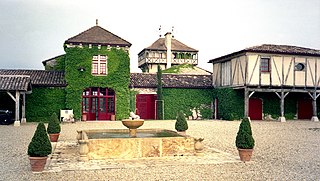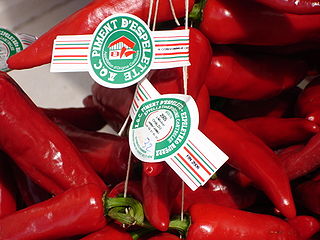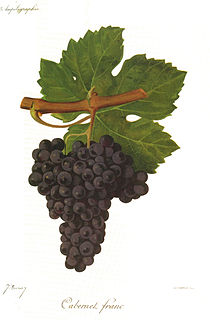Château Brane-Cantenac is a winery in the Margaux appellation of the Bordeaux wine region of France. The wine produced here was classified as one of fifteen Deuxièmes Crus in the original Bordeaux Wine Official Classification of 1855.

Château Haut-Bailly is a Bordeaux wine from the Pessac-Léognan appellation, ranked among the Crus Classés for red wine in the Classification of Graves wine of 1953 and 1959. The winery and vineyards are located south of the city of Bordeaux, in the commune of Léognan.

Château Saint-Pierre is a winery in the Saint-Julien appellation of the Bordeaux region of France. The wine produced here was classified as one of ten Quatrièmes Crus Classés in the historic Bordeaux Wine Official Classification of 1855.

Château Grand Corbin-Despagne is a wine from the Saint-Émilion appellation of the Bordeaux wine region of France, ranked a Grand Cru in the Classification of Saint-Émilion wine. The winery is located in the northern part of the Saint-Émilion commune, close to the border of Pomerol.
Château Laville Haut-Brion was a Bordeaux dry white wine from the Pessac-Léognan appellation, which was ranked among the Crus Classés in the Classification of Graves wine of 1953. The estate is located in close vicinity of the city of Bordeaux, in the commune of Talence.

Château Latour-Martillac, previously Château La Tour-Martillac and known as Kressmann La Tour, is a Bordeaux wine from the Pessac-Léognan appellation, rated a Cru Classé in the 1953 Classification of Graves wine. The winery is located in the central part of France’s Bordeaux wine region Graves, in the commune of Martillac.
Château La Tour Blanche, or La Tour-Blanche, is a sweet white wine ranked as Premier Cru Classé in the original Bordeaux Wine Official Classification of 1855. Belonging to the Sauternes appellation in Gironde, in the region of Graves, the winery is located in the commune of Bommes.

Château Carbonnieux is a Bordeaux wine estate located in the Pessac-Léognan region of the Graves. The estate was one of the first estates included in the Graves wine classification and is known for its red and white wine production.
Château Rieussec is a sweet white wine ranked as Premier Cru Classé in the original Bordeaux Wine Official Classification of 1855. Belonging to the Sauternes appellation in Gironde, in the region of Graves, the winery is located in the commune of Fargues.

Château de Malle is a sweet white wine ranked as Second Cru Classé in the original Bordeaux Wine Official Classification of 1855. Belonging to the Sauternes appellation in Gironde, in the region of Graves, the winery is located in the commune of Sauternes. The gardens of the chateau are classified among the Notable Gardens of France by the Committee of Parks and Gardens of the French Ministry of Culture.
Domaine de Chevalier is a Bordeaux wine from the Pessac-Léognan appellation, ranked among the Crus Classés for red and white wine in the Classification of Graves wine of 1953 and 1959. The winery and vineyards are located south of the city of Bordeaux, in the commune of Léognan. It is one of a very few Bordeaux estates to be named domaine instead of château.
Château Pape Clément is a Bordeaux wine from the Pessac-Léognan appellation, ranked among the Crus Classés for red and white wine in the Classification of Graves wine of 1959. It is the oldest wine estate in Bordeaux, harvesting its 700th vintage in 2006. The winery and vineyards are located in the commune of Pessac, south-west of the city of Bordeaux. When the estate was omitted from the initial Graves classification of 1953 it caused some controversy.

Château Malartic-Lagravière, originally Domaine de Lagravière, is a Bordeaux wine from the Pessac-Léognan appellation, ranked among the Crus Classés for red and white wine in the Classification of Graves wine of 1953 and 1959. The winery and vineyards are located south of the city of Bordeaux, in the commune of Léognan.

Château Smith Haut Lafitte is a Bordeaux wine from the Pessac-Léognan appellation, ranked among the Crus Classés for red wine in the Classification of Graves wine of 1953 and 1959. The winery and vineyards are located south of the city of Bordeaux, in the commune of Martillac.
Vieux Château Certan is a Bordeaux wine from the appellation Pomerol. The winery is located on the Right Bank of the Bordeaux wine region, in the commune of Pomerol in the department Gironde. As all wine produced in this appellation, Vieux Château Certan is unclassified, but the estate is long recognised as among the great growths of the region, and by some reckoned comparable to neighbouring estate Château Pétrus.
Château Brown is a Bordeaux wine from the Pessac-Léognan appellation, unranked in the Classification of Graves wine. The winery and vineyards are located south of the city of Bordeaux, just north of Château Olivier with property within the communes of Gradignan, Villenave-d'Ornon and Léognan.
Château Olivier is a Bordeaux wine from the Pessac-Léognan appellation, ranked among the Crus Classés de Graves for red and dry white wine in the Classification of Graves wine of 1953 and 1959. The winery and vineyards are located south of the city of Bordeaux, in the commune of Léognan.
Château Couhins is a Bordeaux wine from the Pessac-Léognan appellation, ranked among the Crus Classés for dry white wine in the Classification of Graves wine of 1959. The winery is located in close vicinity of the city of Bordeaux, in the commune of Villenave-d'Ornon.
Château Couhins-Lurton is a Bordeaux wine from the Pessac-Léognan appellation, ranked among the Crus Classés for dry white wine in the Classification of Graves wine of 1959. The winery is located in close vicinity of the city of Bordeaux, in the commune of Villenave-d'Ornon.
Château Bouscaut is a Bordeaux wine from the Pessac-Léognan appellation, ranked among the Crus Classés for red and dry white wine in the Classification of Graves wine of 1953 and 1959. The winery and vineyards are located south of the city of Bordeaux, in the commune of Cadaujac.
















